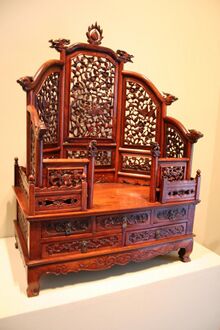Biology:Dalbergia odorifera
| Dalbergia odorifera | |
|---|---|
| Scientific classification | |
| Kingdom: | Plantae |
| Clade: | Tracheophytes |
| Clade: | Angiosperms |
| Clade: | Eudicots |
| Clade: | Rosids |
| Order: | Fabales |
| Family: | Fabaceae |
| Subfamily: | Faboideae |
| Genus: | Dalbergia |
| Species: | D. odorifera
|
| Binomial name | |
| Dalbergia odorifera T. Chen
| |
| Synonyms[2] | |
| |
Dalbergia odorifera, fragrant rosewood or Chinese rosewood[3] (Chinese: 降香黄檀; pinyin: jiàngxiāng huángtán; literally: 'drooping fragrant dalbergia'), is a species of true rosewood in the genus Dalbergia. It is a small or medium-sized tree, 10–15 metres (33–49 ft) tall.[4] It is endemic to China and occurs in Fujian, Hainan, Zhejiang,[4] and Guangdong.[5]
It is used as a wood product and in folk medicine.[3] This valuable wood is known in China as huali (花梨) or huanghuali (黄花梨).[5] Furniture from the late Ming and early Qing dynasties was made of this wood[5] and new furniture in the same styles are sought after as luxury and prestige items.[6]
Four compounds isolated from the root of this plant have been shown in a laboratory to have antioxidant properties.[7]
A deciduous tree, D. odorifera will start shedding leaves at around December of each year in the Northern Hemisphere. It becomes dormant throughout the winter months.
It was overexploited in the twentieth century and was classed as a vulnerable species in 1998.[1] This reached a level in the early twenty-first century where most trees of a size for commercial use had been cut down. As a consequence, other species of Dalbergia started to be exploited in its place.[6]
References
- ↑ 1.0 1.1 World Conservation Monitoring Centre (1998). "Dalbergia odorifera". IUCN Red List of Threatened Species 1998: e.T32398A9698077. doi:10.2305/IUCN.UK.1998.RLTS.T32398A9698077.en. https://www.iucnredlist.org/species/32398/9698077. Retrieved 14 November 2021.
- ↑ "The Plant List: A Working List of All Plant Species". http://www.theplantlist.org/tpl1.1/record/ild-41443.
- ↑ 3.0 3.1 {{citation | mode = cs1 | title = Dalbergia odorifera | work = Germplasm Resources Information Network (GRIN) | url = | publisher = [[Organization:Agricultural Research ServAgricultural Research Service (ARS), United States Department of Agriculture (USDA) | access-date = 21 January 2018 }}
- ↑ 4.0 4.1 Dezhao Chen; Dianxiang Zhang. "Dalbergia odorifera". Flora of China. Missouri Botanical Garden, St. Louis, MO & Harvard University Herbaria, Cambridge, MA. http://www.efloras.org/florataxon.aspx?flora_id=2&taxon_id=242316792.
- ↑ 5.0 5.1 5.2 "The best Chinese furniture woods". eastcornercompany.com. http://www.eastcornercompany.com/doc/The%20best%20Chinese%20furniture%20woods.pdf.
- ↑ 6.0 6.1 "Siamese Rosewood Dalbergia cochinchinensis". https://www.iucnredlist.org/species/215342548/2822125.
- ↑ Yu, X.; Wang, W.; Yang, M. (2007). "Antioxidant activities of compounds isolated from Dalbergia odorifera T. Chen and their inhibition effects on the decrease of glutathione level of rat lens induced by UV irradiation". Food Chemistry 104 (2): 715–720. doi:10.1016/j.foodchem.2006.10.081.
Wikidata ☰ Q3012291 entry
 |



